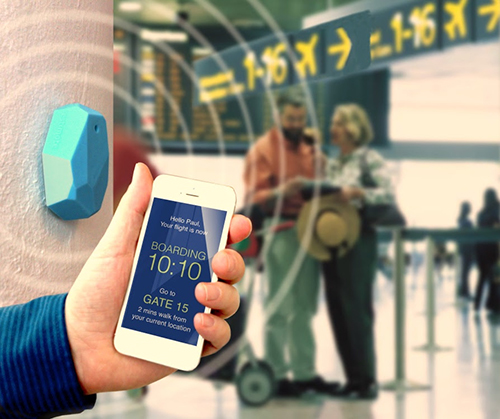 Miami International Airport is the first airport in the world to have a complete and open deployment of beacons. SITA, the IT provider to the air transport industry, announced that there are now beacons registered and available to users via the SITA Common-Use Beacon Registry which cover entrances, check-in, gate, baggage claim and valet parking zones throughout Miami International Airport. Each beacon broadcasts its identifier in the zone and this can be used by airlines, retailers and other partners’ apps to trigger useful content to passengers or staff.
Miami International Airport is the first airport in the world to have a complete and open deployment of beacons. SITA, the IT provider to the air transport industry, announced that there are now beacons registered and available to users via the SITA Common-Use Beacon Registry which cover entrances, check-in, gate, baggage claim and valet parking zones throughout Miami International Airport. Each beacon broadcasts its identifier in the zone and this can be used by airlines, retailers and other partners’ apps to trigger useful content to passengers or staff.
Maurice Jenkins, Division Director, Information Systems, Miami International Airport, said: “The passenger experience at Miami Airport is our number one concern and iBeacon technology allows us make it even better. We have installed beacons throughout the airport and made them available to all our stakeholders. Now we invite airlines and our other partners to invent new ways to make the passenger experience at Miami even better. With our beacons, they can now give passengers relevant information on their phones at every point of their journey through our airport.
“Working with SITA has made it easy for us to do this quickly – onsite deployment took just two days. And by using the SITA Registry, it makes it simple for us to collaborate with our partners, both domestic and international, and let them take advantage of this new technology too. Airlines that fly to Miami are already working on their apps so passengers will start seeing the benefits very soon.”
Jim Peters, SITA Chief Technology Officer, said: “This is a fantastic move by Miami International and a great model for the industry to follow. By installing the beacons and registering them on the SITA Common-Use Beacon Registry, the airport has set the standard for being truly open and collaborative with its partners.
“Miami has made it easy for airlines, and other partners working at the airport, to take advantage of iBeacon technology and provide information that is relevant to the passenger’s location or stage of the journey. And of course, it is not just for passengers; beacons can be used for staff notifications and to beam operational information – such as temperature, noise levels, vibrations, etc – from throughout the airport to allow efficient operational management.”
Beacons offer great opportunities for airlines and airports and by collaborating and working openly the industry can implement this new technology in a consistent way that will allow efficient use, across all airports and airlines’ networks around the world.
Miami Airport’s beacon zones are in operation throughout the terminals, skytrain and car parks to allow way-finding to be offered on passenger’s phones. SITA Lab, the research team at SITA, has already tested the beacons with mapping technology which has proved hugely successful. All of Miami Airport’s beacons are open and available via the SITA Common-Use Beacon Registry so any airline, retailer or other service-provider at the airport can make use of these right away.
For more information on beacon technology and how it can be used today by airlines and airports read SITA’s research results and check out the SITA Common-Use Beacon Registry.



